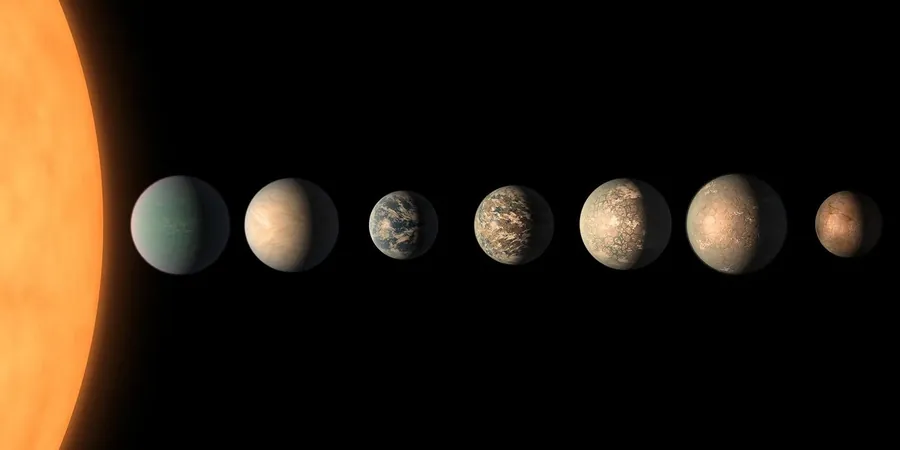
Unlocking the Secrets: How Scientists Are Redefining the Search for Alien Life
2025-06-01
Author: Emma
A Revolutionary Approach to Finding Life Beyond Earth
As we gaze into the cosmos, the quest for extraterrestrial life intensifies. To effectively find signs of life on distant planets, scientists must navigate the intricate chemistry of their atmospheres. Imagine if an alien species were to observe Earth—they'd be on the lookout for clear indicators of life, such as oxygen, a byproduct of photosynthesis from plants and certain bacteria. The challenge lies in identifying reliable chemical 'signatures' that point definitively to life on exoplanets.
Thanks to the powerful James Webb Space Telescope (JWST) and other advanced facilities, researchers are enhancing their search for life. Yet, despite oxygen's prominence in our atmosphere, no other unequivocal chemical indicators of life have emerged. This raises the question: Is it time to abandon the pursuit of a singular 'holy grail' biosignature? A new groundbreaking paper suggests that a more holistic approach—analyzing the dynamic interactions between different atmospheric chemicals—could lead to discoveries of life forms that differ from anything on Earth.
Turning to Chemical Networks for Answers
While oxygen often takes center stage as a possible indicator of life, other chemicals can also provide clues. Methane, for example, is produced by living organisms but is also found abundantly from geological processes. This complexity means that relying solely on one gas may lead to misleading conclusions in the search for life. In a recently published paper by researchers Theresa Fisher, Estelle Janin, and Sara Imari Walker, a new methodology is proposed that hinges on analyzing gas interactions through a Chemical Reaction Network (CRN) framework.
A CRN essentially consists of a series of chemical compounds that react with one another, resulting in transformations. By examining the structure of these networks, scientists can derive insights about the atmospheric processes occurring on a given planet. This knowledge could illuminate the types of life that might exist or even clarify if there’s completely no life present.
Insights from Simulations: Classifying Atmospheric Gases
In their study, the researchers aimed to differentiate between biological, abiotic, and unidentified sources of biosignature gases within simulated Earth-like atmospheres. They analyzed 30,000 scenarios, categorizing them into "Archaean-Earth-like" and "modern Earth-like" worlds. The former represents planets with atmospheres resembling those of early Earth, characterized by minimal oxygen and a predominance of methane, suggesting potential habitability for primitive life forms.
On the other hand, modern Earth-like worlds are rich in nitrogen and oxygen, similar to our current atmosphere, and influenced by human activities, such as the release of chlorofluorocarbons (CFCs). By studying the atmospheric characteristics of these worlds, researchers sought to understand the origins of methane and its efficacy as a potential life indicator.
Utilizing a Systems Approach for Future Discoveries
The unified systems approach proposed by the researchers relies on continuous data collection from exoplanet studies. Through CRN analysis, scientists can detect atmospheric shifts that may indicate life. These could include simple gases emitted by microbial life or complex mixtures stemming from advanced civilizations.
Furthermore, this method has the potential to offer insights into whether life on other planets resembles our own or if it is entirely alien. As telescopes gather more data, the CRN approach could also help differentiate between genuine biosignatures and anomalies, paving the way for groundbreaking discoveries in our quest to understand life's mysteries beyond Earth.









 Brasil (PT)
Brasil (PT)
 Canada (EN)
Canada (EN)
 Chile (ES)
Chile (ES)
 Česko (CS)
Česko (CS)
 대한민국 (KO)
대한민국 (KO)
 España (ES)
España (ES)
 France (FR)
France (FR)
 Hong Kong (EN)
Hong Kong (EN)
 Italia (IT)
Italia (IT)
 日本 (JA)
日本 (JA)
 Magyarország (HU)
Magyarország (HU)
 Norge (NO)
Norge (NO)
 Polska (PL)
Polska (PL)
 Schweiz (DE)
Schweiz (DE)
 Singapore (EN)
Singapore (EN)
 Sverige (SV)
Sverige (SV)
 Suomi (FI)
Suomi (FI)
 Türkiye (TR)
Türkiye (TR)
 الإمارات العربية المتحدة (AR)
الإمارات العربية المتحدة (AR)